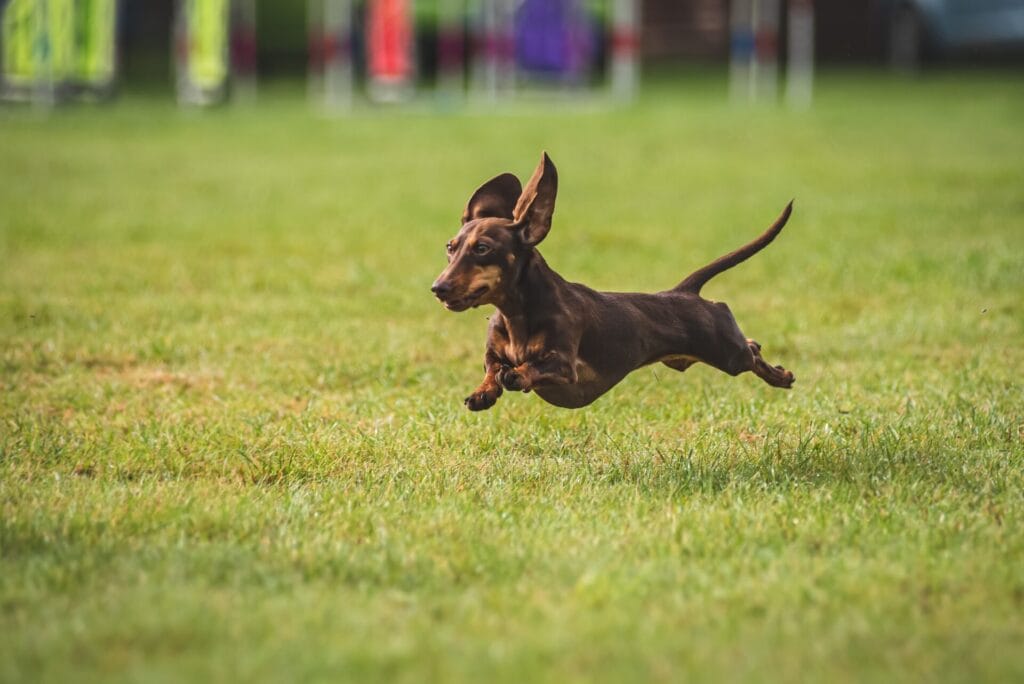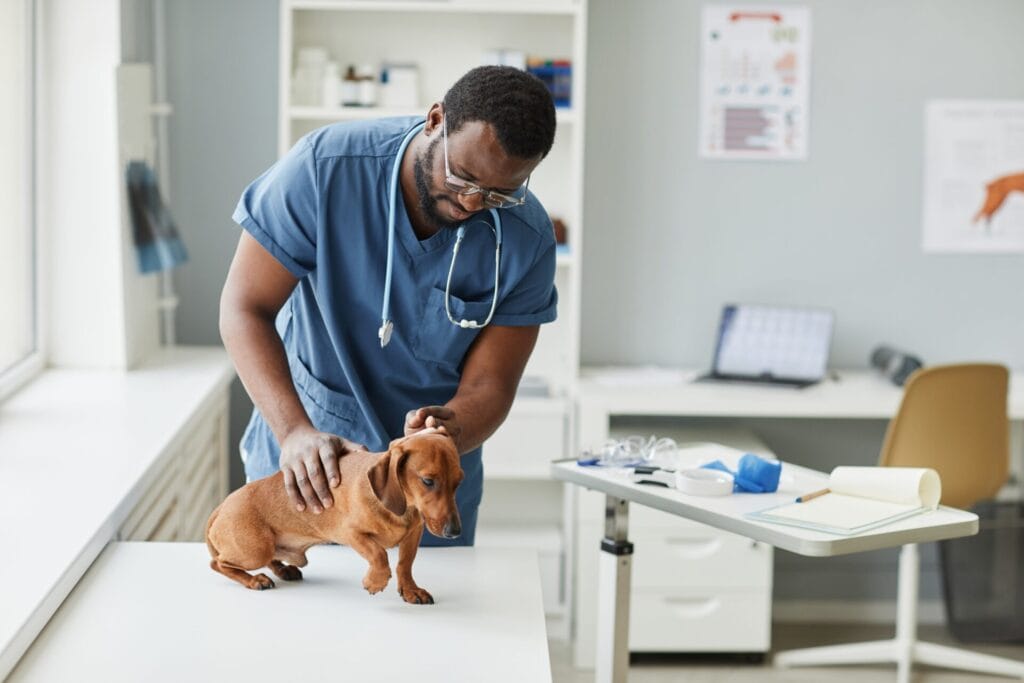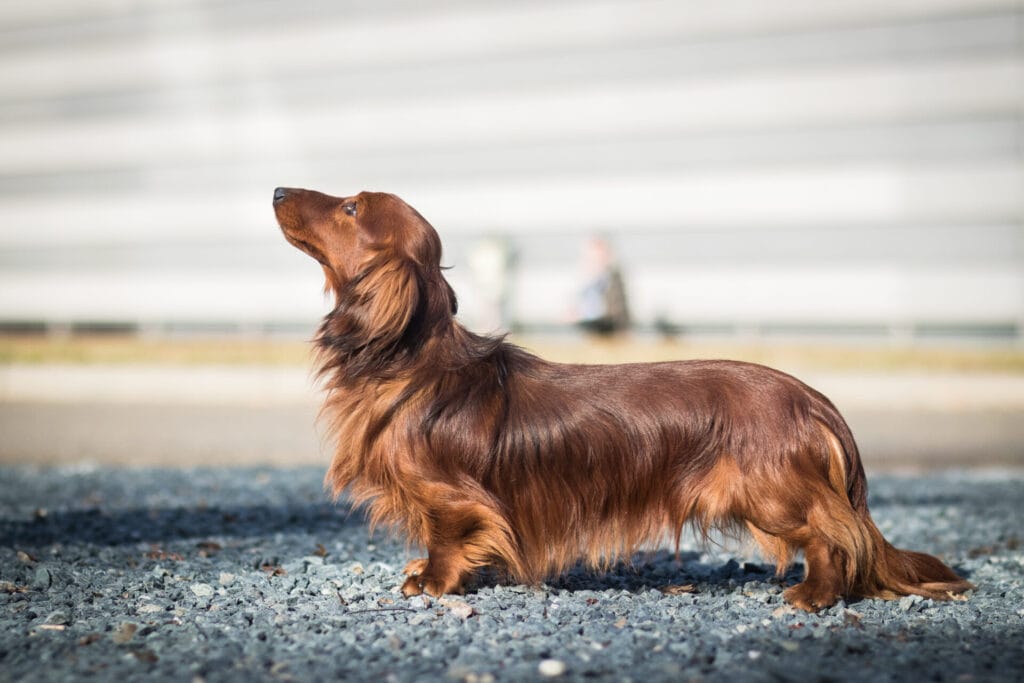Dachshunds are a small yet sprightly dog breed. However, without the proper care, you may start noticing typical back problems in Dachshunds.

Wiener dogs, Doxies, sausage dogs or maybe you just call ‘em Dachshunds! These little guys have elongated backs and short legs that give them such a distinct appearance. Unfortunately, this also makes them susceptible to painful back conditions. If you’re a wiener dog owner, then this article is for you as we take you through:
- Common back problems in Dachshunds, what you need to know
- Signs of pain in Dachshunds
- How to avoid back problems in Dachshunds
- Keeping Dachshunds fit and healthy
- Getting vet help when you need for your Dachshund’s back
What are the common back problems in Dachshunds?
Intervertebral Disc Disease (IVDD)
IVDD is the most prevalent back condition in Dachshunds. The discs between the vertebrae can bulge or rupture, putting pressure on the spinal cord and cause pain, nerve damage or even paralysis. IVDD can range from mild back pain to severe cases requiring surgery.
Degenerative Disc Disease (DDD)
Over time, the spinal discs in dachshunds can degenerate and break down, leading to instability, pain, and reduced mobility. This gradual deterioration of the discs puts strain on the spine.
Osteoarthritis
The constant stress on a dachshund’s elongated spine can cause wear-and-tear arthritis in the joints between the vertebrae, resulting in pain, stiffness, and difficulty moving.
How do I tell if my Dachshund has hurt their back or is in pain?
Body language, vocalization and general mood are key indicators of pain in dogs, Doxies included.
Behavioral changes
Sudden onset of changes in your dog’s behavior often link to pain. These can be subtle or look more obvious. Watch out for the following:
- Growling or snapping when touched
- Suddenly going quiet or withdrawing
- Changes in sleep patterns – Sleeping more, or less
- Struggling to move around or lower head to eat or drink
- Clinginess or wanting lots of attention
- Licking or overgrooming – particularly paws
- Pacing or restlessness
Vocalization
We know wieners are quite noisy characters, after all it is what they were bred to do, alert us to the badger (!), but the type of vocalization we will see of a dog in pain is quite different.
- Yelping, crying out, or whimpering – especially when being picked up, jumping, or moving around
- Groaning or grunting when moving around
- Growling when being asked to move places
Other physical signs of back problems in Dachshunds
- Hunched or arched back
- Difficulty getting up, lying down, or changing position
- Biting or fussing their back
- Shaking or trembling
- Hot spots
Keeping a record of your Doxie’s behavior and any signs that they might be in pain, will be useful if you need to see your Veterinarian.

How to avoid back problems in Dachshunds
There are some best practices to follow to protect your Dachshund’s back, and keep them as healthy as possible!
Avoid stairs and steps, instead use a ramp
Repeated use of stairs and steps puts stress and pressure on a Doxie’s back. Use ramps and teach them to use them with positive reinforcement training and treats so that getting on and off the couch (or your bed, it’s fine to have them in there, we won’t tell anyone!) can be done without damaging their back.
Take care when carrying or picking up your Dachshund
Be sure to swoop and support them from the underneath to avoid curving or curling the spine. They may be your baby, but they are not ‘a’ baby so don’t pick them up under the armpits like one.
Help them maintain a healthy weight
We don’t want to fat shame, but Dachshunds can and do often carry too much weight, and this puts a lot of strain on those fragile backs. We are responsible for what they eat, so it’s on us to keep them trim.
Get personalized dietary advice and choose the right food for your Dachshund at Spot and Tango!
Get them a well supporting bed
Dachshunds spend a lot of time asleep, so opt for orthopedic or memory foam bedding that conforms to your Dachshund’s body shape and provides adequate support. A comfortable bed can help relieve pressure on their spine and joints, enhancing their sleep quality and reducing the risk of back pain.
Appropriate exercise can help prevent back problems in Dachshunds
They may have little legs, but regular exercise is still important for your Dachshund to keep them fit, healthy and get a strong core and back. You could even join a canine fitness or how about a Doga class?
Use a bag or stroller
If you’re concerned about your Dachshund overexercising (especially if they are a senior dog) then get them a comfortable, long bag to travel in, or use a dog-stroller. They’re a dog mom essential these days, and it will mean your Doxie can still enjoy life out and about.
Ask about back problems in Dachshunds at your vet check-ups
It’s important for Doxies to have at least annual check-ups, so your Veterinarian can keep an eye on things. Early intervention and lifestyle changes are much easier to do than leaving things too late and your Doxie requiring expensive and painful surgery. Your Vet clinic will be happy for you to pop in for a smooch, we promise!

How to keep Dachshunds fit and healthy
Diet and physical activity are both critical to keep your Doxie fit and healthy. It’s also important to think about mental activity too, how you can train them in cooperative care and actively train them, in order to future proof against any health issues.
Scentwork
Dachshunds, whether miniature or standard, smoothie, wire-haired or long-haired, dappled brindle, sable, or piebald, all have one thing in common, their brilliant noses!
Bred to sniff out Badger setts a Dachshund (or Badger hound to give you the literal translation) use your Doxie’s strongest sense, they will go wild for scentwork training, and it’s a brilliant way to mentally tire them.
Cooperative Care Training
Cooperative care includes things like checking your Dachshund’s eyes, ears, teeth and paws, or checking their heart and teaching them to be comfortable at being restrained. Vet visits are a non-negotiable when you have a sausage dog, so use positive training with plenty of Spot and Tango treats to teach them to be happy being examined, handled, and to build up positive associations.
Find a Dog Sport that helps prevent back problems in Dachshunds
Don’t be fooled, they’re not just sofa hounds, Dachshunds can and do enjoy dog sports too – Barn Hunt is one they are particularly good at, as are other scent based activities like Tracking and Trailing. Of course, they can do obedience or Rally O and even though they need the heights adjusted, they are also brilliant at Agility!
We also think teaching the more tricks the better, because we just love showing off how clever our Dachshunds are to our friends.
When should a Dachshund owner seek veterinary care for back problems?
Throughout their life if we’re honest, regular check-ups and preventative care should mean you get to know your Veterinarian on a first name basis. Other than that, as soon as you spot signs your dog is at all uncomfortable, it is always better to be safe than sorry with our little wieners!

Early intervention for back problems in Dachshunds
Early diagnosis and treatment of back issues can prevent further complications and improve the prognosis for your dachshund’s recovery. Consultation with a veterinarian specializing in spinal issues can provide tailored treatment options to address your pet’s specific needs.
Consult with a Dachshund spinal specialist
Yes, dog neurologists are a thing, and getting your Dachshund to see one when they have back problems is truly recommended. Only the best for our darling sausage dogs!
We hope this article has given you some insight into how to protect and prevent back problems in Dachshunds. Remember, feeding them a complete and appropriate food is one easy way to keep your Dachshund healthy. Check out the full range at Spot and Tango.




















